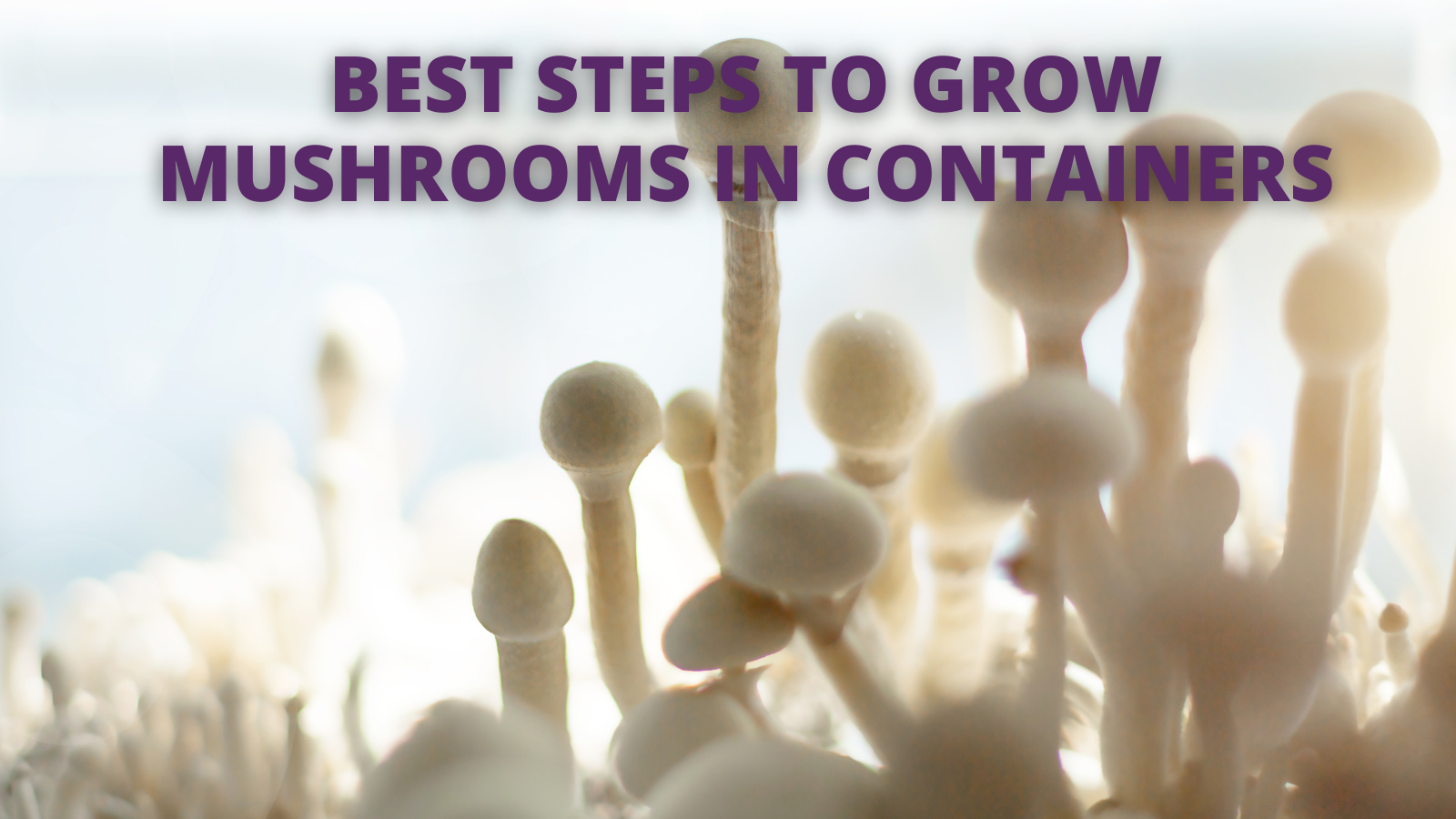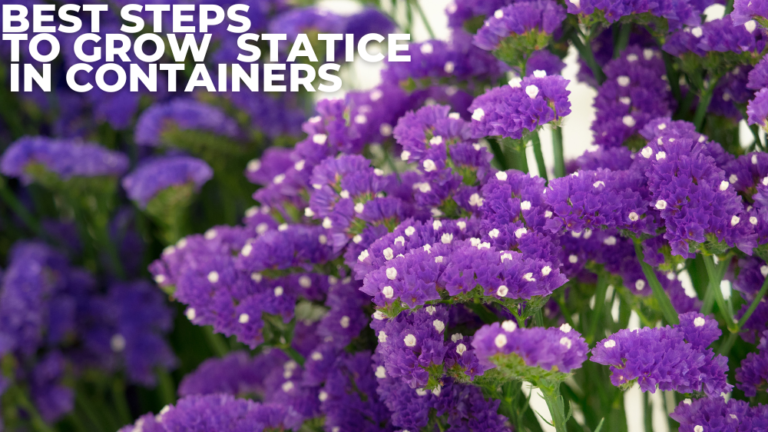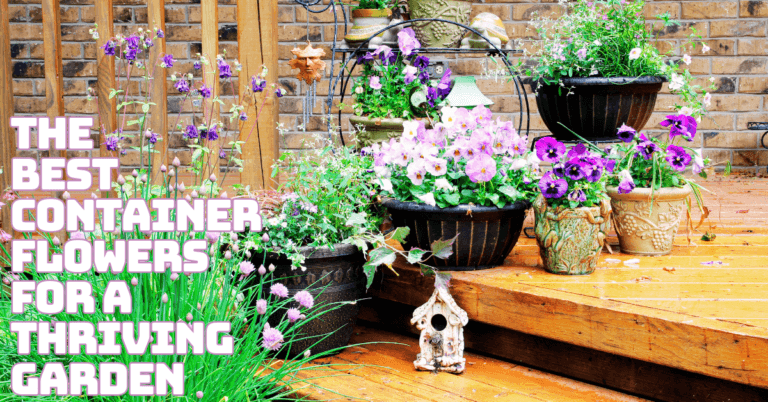Best Steps To Grow Mushrooms In Containers
Best Steps To Grow Mushrooms In Containers
A mushroom is the edible body of a fungus that grows above ground on soil or another food source. White button mushrooms are the most common type of mushroom sold in stores.
Numerous diverse varieties of mushrooms can be identified by their gills; some can grow with or without stems.
The mushrooms with a stem and gills on the underside of the cap are known as Agaricus bisporus.
Growing mushrooms at home is an intriguing chore for gardeners interested in growing food.
Mushrooms produce minute spores in their gills, which aid the fungus in spreading across the ground or on its growing source. Mushrooms are the ideal food to add to a healthy diet.
Mushrooms contain a lot of fibre, potassium, and selenium but few calories and fat. The blog will show you how to grow mushrooms in containers.
History & Origin Of Mushrooms
The idea of our ancestors “discovering” a new mushroom species for the first time intrigues many, especially given how different they can seem.
Many wild mushrooms are poisonous, with some being fatal, making this situation much more intriguing.
How did people know which mushrooms were poisonous, which were psychedelic, and which were edible?
We probably won't ever fully understand how early humans first learned about edible and toxic mushrooms until time travel becomes a reality.
But there are a few reasonable hypotheses, some of which might be true. First, it's possible that our forefathers observed the species' diet in the area.
People might feel secure, presuming a mushroom species is safe if deer, boar, and other animals consume it without experiencing harmful consequences.
Additionally, it's possible that they ate unidentified mushrooms in small amounts, which could have allowed them to experience the terrible side effects without dying.
Before being exposed to the delectable fungi through international trade, we knew that not everyone on every continent liked mushrooms.
For instance, it took until the late 1800s for Americans to start cooking with mushrooms regularly after being introduced to haute cuisine in France.
At that period, mushrooms had long been a favourite food across many civilizations.
Types Of Mushrooms
Mushrooms are a luxury for some people. They are a go-to culinary staple for anyone who wants rich, potent flavours and chewy bites that add something special to a meal because of their earthiness and meaty textures.
However, mushrooms are off-limits to some people. If you belong to the latter group, it's possible that you haven't yet encountered a mushroom kind that you genuinely enjoy.
To grow mushrooms in containers perfectly, you must know the best varieties.
1. Button Mushrooms
We'll presume you've only ever tasted button mushrooms if you've eaten any other kind.
It's likely that every time you visit the produce aisle at your local grocery store, you will see this particular kind of mushroom.
Buttons are harvested early in their growth cycle, although cremini and portobello mushrooms (which we'll discuss later) are of the same species.
The result is a mild, fairly unimpressive flavour. If you're searching for something quick, simple, and reasonably priced, button mushrooms are a good alternative. However, if you don't like them, you should try other dishes.
2. Shiitake Mushrooms
Shiitake mushrooms are frequently found in various East Asian recipes, so if you're familiar with Asian cuisine, you may have already encountered them.
They often appear in healthy soups because some think they offer therapeutic advantages. If you're generally a button mushroom person, they might not seem like what you're used to seeing: Shiitake mushrooms feature broad caps with an umbrella shape and thin stalks.
Curious about their flavour? We believe they tend to be tastier than button mushrooms because they are not very potent, making them excellent for novices.
When eaten raw, Shiitake mushrooms have an earthy, woodsy flavour but a delicious umami flavour when cooked.
3. Maitake Mushrooms (Grifola frondosa)
While certain mushrooms are straightforward to locate at your neighbourhood grocery store, others are more difficult.
You're lucky if your community has a thriving farmers market that offers mushrooms since you can probably get maitake mushrooms, often known as “hen of the woods,” there.
The only place else to find this specific mushroom is in the woods. If you don't understand fungi thoroughly, you must avoid collecting mushrooms from the wild because many of them can be exceedingly dangerous.
Who knows, though? The next time you go hiking, you might be able to see some of them.
4. Cremini Mushrooms
The information on button mushrooms is already known, but what about cremini mushrooms?
Baby Bella mushrooms belong to the same species as button mushrooms but are only harvested when they mature.
Compared to their younger counterparts, they are meatier and tastier since they have had more time to develop.
This is why we typically like cremini mushrooms over button mushrooms (but if you're not a huge mushroom fan, the opposite may be true for you).
Since most mushroom recipes include them, these mushrooms are also incredibly adaptable.
5. Enoki Mushrooms (Flammulina filiformis)
Enoki mushrooms could look odd to someone who isn't already a fungi fan. Keep reading, though:
These are some of our favourite mushrooms; we believe you'll also appreciate them if you give them a chance.
They have several branches on their long, slender stalks. Those stalks have tiny tops that resemble buttons.
These mushrooms are consumed communally rather than singly. Enoki mushrooms are utilized in various Asian recipes.
You may cook the bundle of mushrooms in multiple ways or serve them raw to give a salad or vegetable some delightful crunch.
Grow Mushrooms In Containers
Any gardener interested in producing their food should try their hand at cultivating mushrooms.
Given their low calorie and fat content, high fiber content, and increased potassium and selenium content, mushrooms complement any diet.
The optimum circumstances for mushroom growth are found indoors, where it is easier to control the temperature and lighting.
It takes careful management of mushroom growing conditions to learn how to cultivate them inside.
1. Choose The Right Container To Grow Mushrooms
Container gardening is perfect for mushrooms. Outdoors, mushrooms can be grown on trees or in certain places, but edible mushrooms must develop in special containers with special growing mediums.
Plastic trash bags, plastic containers, or laundry baskets make excellent mushroom-growing containers.
Choose containers 8 to 12 inches deep with a reliable drainage system. Warm water and gentle antiseptic soaps can be used to clean and sterilize the container.
2. Location To Grow Mushrooms
For growing mushrooms, use a site that offers complete shadow or darkness. You should be able to control the temperature at the location.
Placing mushroom containers requires a closed cabin, a disused closed nook, a dark indoor area, or even an empty kitchen cabinet.
Mushroom cultivation can begin once you select the mushroom variety, container, growing media, and location.
3. Planting Mushrooms
Put the substrate in the appropriate location. If the substrate has properly colonized, it should be completely coated with what appears to be a white fuzz after two weeks.
This could take two to four weeks. If the substrate has been colonized, relocate the pan to a dark, chilly location (about 55°F or 13°C).
Remove these regions from your substrate and toss them out if you find any dark spots of green or brown (like what you may see on mouldy bread).
A basement typically works well, but a cabinet or drawer in an unheated room will suffice in winter.
Spread potting soil over the substrate before misting the mixture with water to completely dampen it. You can drape a damp towel over the pan if you'd like to stop moisture loss.
A low-heat lamp may be placed close to the pan. This mimics the sun, which may aid the mushrooms in finding their direction and growing “up,” making them simpler to harvest.
The mixture needs to be kept cool and moist as the mushrooms develop. When necessary, check it frequently and give it a water spritz.
Although the mushrooms prefer a more relaxed atmosphere, avoiding overheating them is essential. Your mushrooms should thrive if temperatures below 70°F (21°C).
4. Growing Mushrooms From Coffee Grounds
Procure coffee grounds. Coffee grounds typically go to waste unless you take the time to grow mushrooms from them, which is a great project.
Because they have previously been sterilized during the coffee-brewing process and are rich in nutrients, coffee grounds provide an excellent growing medium for mushrooms, especially oyster mushrooms.
2.5 kg (88 oz) of fresh coffee grounds are required to make 500 g (17.6 oz) of mushroom spawn. Going to a café and making a polite request is the best way to obtain these freshly brewed coffee grounds.
Usually, they are more than eager to give it away. Find a container to store the mushrooms. A filter patch grows bag, typically available along with the mushroom spawn, is the best item to use.
Alternately, you can use a sizable freezer bag that can be sealed, a sterilized milk carton or ice cream tub, and four tiny holes drilled into the edges of the container. Transfer the spawn into the container.
To ensure that the mushroom spawn is distributed uniformly, thoroughly wash your hands with antibacterial soap before combining it with the coffee grounds.
Put the inoculated coffee grinds in the plastic bag or container and seal it up firmly before setting the mushrooms in the appropriate location.
Place the bag or container in a warm, dark environment between 64 and 77°F (18 and 25°C), such as an airing cupboard or beneath a sink.
As the mycelia colonizes, the coffee grinds, let it here for two to four weeks or until it turns completely white.
Once more, remove any dark patches of green or brown on the colonization substrate, as they may make you ill.
Transfer the mushrooms. After the contents of the bag or container have turned entirely white, transfer it to a bright area (but out of direct sunlight) and make a 2″ by 2″ hole in the top.
To keep the contents of the container from drying out, mist them with water twice a day; otherwise, the mushrooms won't grow there.
5. Fertilizer To Grow Mushrooms
The nutrients that mushrooms require to grow are provided by compost. For mushroom compost, two types of material are typically utilized, with wheat straw-bedded horse manure being the most common and least expensive.
A cold, dark atmosphere and the right combination of nutrients are extremely specialized requirements for mushroom growth.
A compost formed from manure will provide the appropriate levels of nitrogen that mushrooms require to develop, and creating this fertilizer at home will lower your production costs even further.
6. Sunlight To Grow Mushrooms
Since mushrooms don't have chlorophyll, they can grow without light or photosynthesis. For mushrooms to spawn, the habitat has to be as dark as possible, but some light does not impair their growth.
Although they only need a few hours daily for successful fruiting, mushrooms need dim light to create fruit bodies. Indirect sunlight or a fluorescent bulb can be used to cultivate mushrooms indoors.
Wild mushrooms frequently flourish in wooded, shaded locations where they receive filtered light.
7. Water & Humidity To Grow Mushrooms
Mushrooms need moisture to grow their fruit, but moisture is easily lost since they don't have skin.
Mushrooms need a high-humidity environment to prevent water loss. It is possible to “drown” mushrooms since they breathe and exchange gases with the environment.
The soil should be damp, not wet, while mushrooms are growing inside. When the weather is dry, wild mushrooms growing outside disappear; they may return when humidity and moisture levels improve.
8. Sterilizing The Growing Medium For Mushrooms
Make the growing medium germ-free. When growing mushrooms in sawdust or straw, these ever-increasing mediums must be disinfected before being inoculated with spawn.
This eliminates any microbes that would compete with the mycelia. Put the substrate in a microwave-safe bowl with enough water to dampen the straw or sawdust.
The bowl should be heated in the microwave for two minutes or until the water has completely boiled off.
By eliminating any remaining microbes, the substrate can accept the mushroom mycelia. You might need to operate in batches to thoroughly disinfect the straw or sawdust.
Warm up the substrate to encourage mycelia growth. The mycelia in your mushroom spawn must cover the substrate extensively.
A warm environment promotes this growth. Pick the substrate that will work best for your particular type of mushrooms, then add a few handfuls of it to a baking pan.
Your mushrooms will have the most room to develop in a shallow pan with a broad surface area. Utilizing a sterile tool, combine the spawn with the substrate.
Put the baking pan on a heating pad that preheats to 70°F (21°C). This temperature is perfect for promoting growth. Another option is to just put the pan somewhere warm in your house.
9. Use Alternative Mushroom Growing Methods
Utilize a kit to grow mushrooms. Growing mushrooms from a ready-made kit can be an enjoyable and simple way for novice growers to cultivate your mushrooms.
You need to maintain the right conditions for the bag, and you'll have your supply of mushrooms in seven to ten days.
Most popular mushroom kinds, like the white button, crimini, portobello, lion's mane, shiitake, and oyster mushrooms, may be grown using kits, typically costing between $20 and $30.
Open the bag to start the growth process and set it somewhere bright but out of direct sunlight, like a shaded windowsill. You can keep the kit in a room.
The kit can be stored at room temperature, but water must be misted over it daily to maintain a high humidity level. Some kits include plastic tents for covering the bag and preserving humidity levels.
After seven to ten days, the mushrooms will begin to sprout, but you may anticipate seeing two or three flushes of development throughout three months.
The wonderful thing about these kits is that you can bury them outside beneath mulch made of bark after they have finished producing mushrooms or in your compost pile. Then, based on the climate, mushrooms may begin to grow there.
10. Harvesting Mushrooms
The mushrooms have grown so much that it appears as though the edge of their caps is starting to curl upwards, and your bucket has pinned.
The optimal time to pick mushrooms is right before this moment because they will start releasing their spores.
Early harvesting lowers the risk of bugs getting inside when ripening them outdoors. Cutting off the oysters in complete clusters at the back, up against the bucket, with a sharp knife can be harvested.
Once the harvest is complete, boil them immediately or put them in a paper bag and keep them in the refrigerator for 5 to 7 days. It's best to use them right away!
Suppose you store your after-harvest, place the bucket in an appropriate (shady, humid) position after harvest, or bury the entire block of straw in your yard's vegetable garden or shady area.
In that case, you may receive a second or third flush of mushrooms during the summer and fall.
Conclusion
Due to their high nutrient content and numerous health advantages, mushrooms are considered a superfood.
If you want to, you can eat mushrooms daily, but only as part of a varied diet. Although mushrooms come in various sizes and forms, each 96g serving contains the same amount of nutrients. So don't miss growing mushrooms in containers.
>>>Please click here to find some delicious Oyster mushroom recipes<<<
I trust you enjoyed this article on the Best Steps To Grow Mushrooms In Containers. Please stay tuned for more blog posts to come shortly. Take care!
JeannetteZ
>>>Please click here to read my all-inclusive article about Container Gardening<<<
>>>Are you interested in homegrown herbs and medicine? Please click here to find out more about it!<<<
Your Opinion Is Important To Me
Do you have thoughts, ideas, or questions? I would love to hear from you. Please leave me your questions, experience, and remarks about this article about the Best Steps To Grow Mushrooms In Containers in the comments section below. You can also email me at Jeannette@Close-To-Nature.org.
Disclosure
This post may contain affiliate links. As an Amazon Associate and other affiliate programs, I earn from qualifying purchases at no extra cost to you. Read my full affiliate disclosure.
You might also enjoy these blog posts:
Best Steps To Grow Ocra In Containers
Best Steps To Grow Drumstick Alliums In Containers
Best Steps To Grow Ylang In Containers
Best Steps To Grow Cloves In Containers
Best Steps To Grow Eucalyptus In Containers




















